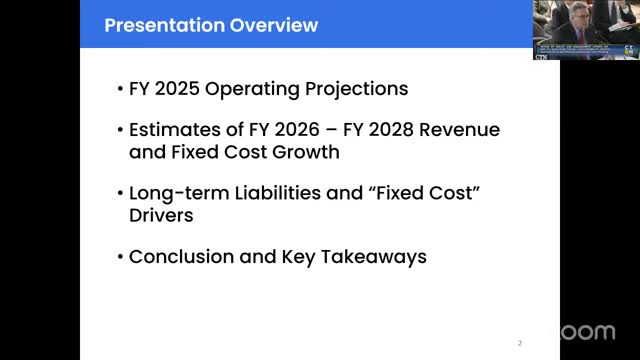Fiscal report reveals $1 billion revenue surge but warns on fixed cost growth
January 01, 2025 | Appropriations, House of Representatives, Committees, Legislative, Connecticut
This article was created by AI summarizing key points discussed. AI makes mistakes, so for full details and context, please refer to the video of the full meeting. Please report any errors so we can fix them. Report an error »

Connecticut's House of Representatives Appropriations Committee convened on January 1, 2025, to discuss the state's fiscal accountability, focusing on the operating projections for fiscal year 2025 and beyond. The meeting highlighted anticipated operating surpluses in both the General Fund and the Special Transportation Fund, despite a significant increase in spending that exceeds current appropriations by $383.7 million.
The committee's analysis revealed that while revenue growth is expected to lag behind fixed cost growth in the first year of the upcoming biennium (2026), projections improve in subsequent years. Key cost drivers identified include Medicaid and retiree health expenses, which are contributing to the financial pressures faced by the state.
In terms of long-term liabilities, the committee reported that Connecticut has made substantial contributions—approximately $8.6 billion—toward reducing its pension fund debt. This effort has decreased the state's actuarially determined employer contribution requirements by $730 million, a positive development that underscores the General Assembly's support for pension reform. However, despite this progress, Connecticut's pension funds remain among the least funded in the nation.
The meeting also addressed revenue forecasts, noting positive changes in certain tax types, including estimates and finals, as well as the pass-through entity tax. However, challenges persist, particularly with the health provider tax, which is falling short due to some hospitals struggling to meet their tax obligations.
As the committee prepares for further discussions in February, the focus will remain on addressing the financial challenges ahead, ensuring that revenue growth can outpace fixed costs in the coming years, and continuing efforts to stabilize the state's long-term financial health.
The committee's analysis revealed that while revenue growth is expected to lag behind fixed cost growth in the first year of the upcoming biennium (2026), projections improve in subsequent years. Key cost drivers identified include Medicaid and retiree health expenses, which are contributing to the financial pressures faced by the state.
In terms of long-term liabilities, the committee reported that Connecticut has made substantial contributions—approximately $8.6 billion—toward reducing its pension fund debt. This effort has decreased the state's actuarially determined employer contribution requirements by $730 million, a positive development that underscores the General Assembly's support for pension reform. However, despite this progress, Connecticut's pension funds remain among the least funded in the nation.
The meeting also addressed revenue forecasts, noting positive changes in certain tax types, including estimates and finals, as well as the pass-through entity tax. However, challenges persist, particularly with the health provider tax, which is falling short due to some hospitals struggling to meet their tax obligations.
As the committee prepares for further discussions in February, the focus will remain on addressing the financial challenges ahead, ensuring that revenue growth can outpace fixed costs in the coming years, and continuing efforts to stabilize the state's long-term financial health.
View full meeting
This article is based on a recent meeting—watch the full video and explore the complete transcript for deeper insights into the discussion.
View full meeting
